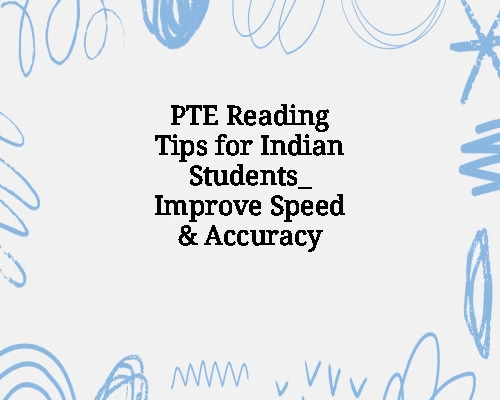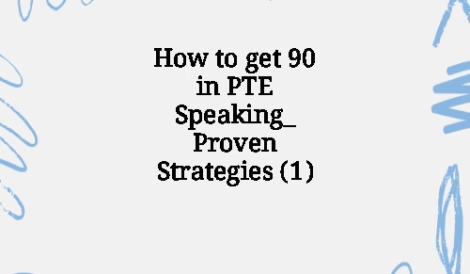PTE Reading Tips for Indian Students_ Improve Speed & Accuracy
PTE Reading Tips for Indian Students: Improve Speed & Accuracy
Boost your PTE Reading score with proven tips tailored for Indian test-takers, focusing on time management, comprehension, and high-frequency question types.
Why the Reading Section Matters in PTE
The PTE Academic Reading section assesses your ability to understand academic English and interpret written information. For Indian students, challenges often include vocabulary gaps, slow reading pace, and difficulty with inference-based questions. Improving speed and accuracy can significantly raise your overall score.
Overview of the PTE Reading Section
The Reading section lasts around 29–30 minutes and includes the following item types:
-
Multiple Choice, Choose Single Answer (1–2 items)
-
Multiple Choice, Choose Multiple Answers (1–2 items)
-
Re-order Paragraphs (2–3 items)
-
Reading: Fill in the Blanks (4–5 items)
-
Reading & Writing: Fill in the Blanks (5–6 items)
Each question type is timed collectively, not individually, so managing your time is essential.
Common Challenges Indian Students Face
1. Limited Exposure to Academic Vocabulary
Indian students may not encounter academic English regularly, making it harder to understand context and meaning.
2. Time Mismanagement
Spending too long on tricky questions like “Multiple Choice, Choose Multiple Answers” can reduce time for high-weightage tasks.
3. Grammar Confusion
Confusion with prepositions, verb forms, and sentence structures often affects performance in “Fill in the Blanks.”
Strategies to Improve Reading Speed
Read Daily with Purpose
Incorporate 20–30 minutes of academic reading into your routine. Sources like The Hindu editorial, BBC News, and Scientific American are excellent.
Practice Skimming and Scanning
-
Skimming helps grasp the main idea quickly.
-
Scanning helps locate specific details fast.
Expand Vocabulary Strategically
Focus on high-frequency academic words. Use tools like the Academic Word List (AWL) and Quizlet flashcards to build retention.
Tips for Each Reading Task Type
Multiple Choice, Choose Single Answer
-
Read the question first to know what you’re looking for.
-
Skim the passage to get context.
-
Eliminate wrong answers quickly.
-
Don’t overthink—your first instinct is often correct.
Multiple Choice, Choose Multiple Answers
-
Focus on accuracy over quantity—there’s negative marking.
-
Choose only options directly supported by the text.
-
Avoid assumptions or personal interpretations.
Re-order Paragraphs
-
Identify topic sentences (they usually stand alone).
-
Look for connectives like however, therefore, firstly.
-
Identify pronoun references and chronological clues.
-
Practice using drag-and-drop questions in mock tests.
Reading: Fill in the Blanks
-
Look at the sentence as a whole.
-
Think about collocations (e.g., “make a decision,” “strong argument”).
-
Focus on grammar structure—articles, verbs, tenses.
-
Improve with regular use of PTE practice portals and blanks vocab lists.
Reading & Writing: Fill in the Blanks
-
This is the highest weightage task—spend more time here.
-
Focus on grammar, collocation, and contextual meaning.
-
Learn parts of speech patterns: noun follows an article, verb follows the subject, etc.
Time Management Tips
| Task Type | Ideal Time Per Question |
|---|---|
| Multiple Choice (Single Answer) | 1–1.5 minutes |
| Multiple Choice (Multiple Answer) | 2 minutes |
| Re-order Paragraphs | 2 minutes |
| Reading: Fill in the Blanks | 1.5 minutes |
| Reading & Writing: Fill in Blanks | 2 minutes |
Keep an eye on the progress bar. Don’t linger on any one question too long—move on and come back if time permits.
Grammar Tips for Indian Learners
-
Brush up on subject-verb agreement.
-
Practice tense consistency across a sentence.
-
Understand prepositions in context (e.g., in contrast to, in addition to).
-
Focus on modal verbs (e.g., should, would, might) and how they affect meaning.
Recommended Daily Reading Practice
-
Read an article from a reputable source.
Time yourself: aim for 300 words in 2 minutes. -
Write a summary in 1–2 sentences.
This sharpens your comprehension skills. -
Underline 5 new words and note their meaning and usage.
-
Solve 3–5 PTE Reading questions from any of the five formats.
Use of Technology for Practice
-
PTE Practice Apps: Choose platforms like E2Language, PTE Tutorials, or PTE Practice Test by Pearson.
-
Browser Extensions: Use tools like Grammarly and Google Dictionary to speed up vocabulary and grammar learning.
-
Speech-to-Text Tools: Improve comprehension and paraphrasing through dictation exercises.
Mock Tests and Sectional Practice
Take Weekly Mock Tests
Attempt full-length PTE Reading sections every week to simulate exam pressure.
Analyze Your Mistakes
-
Track incorrect answers and spot patterns.
-
Maintain a mistake journal with explanations.
Focus Areas Before the Exam
Last 7 Days
-
Avoid learning new concepts—revise old ones.
-
Focus on high-score areas like “Reading & Writing: Fill in the Blanks.”
-
Take timed mock tests every two days.
Last 2 Days
-
Practice only lightly.
-
Read familiar articles for confidence.
-
Sleep well and stay hydrated.
Final Thoughts for Indian PTE Aspirants
Improving reading skills for PTE is not just about increasing speed—it’s about understanding. Indian students who approach the Reading section with daily practice, consistent review of grammar, and strategic exam techniques tend to perform well. Remember, success comes not only from hard work but from smart work. Stick to a plan, use the right tools, and your scores will reflect your effort.





